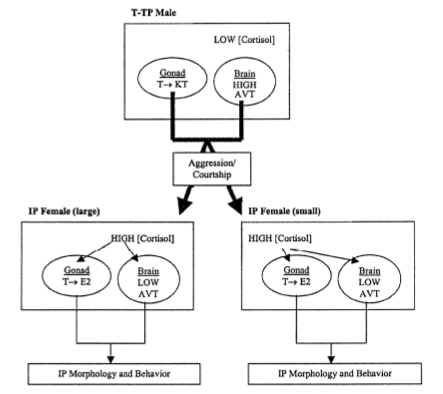Mechanism
As previously mentioned, when the dominant TP male disappears from his harem, the largest IP female is prompted to take over. Once the largest fish of the harem detects the absence of the territorial dominant male, it immediately undergoes transitional changes in order to replace the missing leader. This process is a response to a social cue that is regulated by the change in hormones. During sex change, there are rapid changes in behavior, such as increased aggression and the beginnings of typical T-TP male courtship conduct, as well as permanent color change. Additionally, the gonads in the IP female change dramatically. That is, the ovaries of the IP female that contain no detectable testicular tissue are transformed into perfect testes. Within a week of changing from a large, yellow wrasse to a large, blue and green wrasse, the former female is already producing sperm and fertilizing the eggs laid by the females in the territory.
What is the neurochemical basis of such changes? To recap, aggression and courtship behavior demonstrated by T-TP males is a means of suppressing sex change in IP females as well as NT-TP males. Only when the suppression condition is lifted can sex change take place or be completed (Ross, 1989). The dominated fish are placed under chronic social stress, thereby increasing their levels of cortisol (Perry and Grober, 2003). The changes in the levels of cortisol in turn affect the expression of arginine vasotocin (AVT). Cortisol and AVT have an inverse relationship. For the bluehead wrasse, behavioral sex change is associated with an increase of AVT. Thus, T-TP males have low levels of cortisol and high levels of AVT while the reverse is true for IP females and males. For the suppressed fish, the high amounts of cortisol promote the pathway for estrogen production in the gonads, which accounts for their lower levels of AVT and their lack of typical T-TP male behavior.

In addition to AVT, serum 11-ketotestostrone (11-KT) is involved with the transition from an IP female to a TP male. Whereas AVT is responsible for the behavioral aspect of the sex change, 11-KT is responsible for the physical aspect. As the primary androgen in fish, increased 11-KT, accompanied by a sharp drop of serum estradiol (E2), is the key component of the conversion of the ovary into a testis. Additionally, increases in 11-KT is correlated with the development of color change typical to that of the TP male (Perry and Grober, 2003). Again, much like AVT, 11-KT is affected by the fluctuation of cortisol; elevated cortisol levels results in the inhibition of 11-KT synthesis, thereby keeping gonads intact in suppressed IP females as well as allowing IP males to retain their reproductive function without the TP coloration since the lack of 11-KT production does not affect testosterone levels. In fact, IP fish, both male and female, have undetectable levels of 11-KT. As closely related they are to each other in terms aiding sex change in the bluehead wrasse, 11-KT and AVT systems can act independently of each other. 11-KT does not increase AVT mRNA expression nor is it necessary for the display of such expression. However, 11-KT could still play a role in the responsiveness to exogenous AVT (Semsar and Godwin, 2004).
Interestingly enough, neither the development nor the maintenance of male-typical behavior depends on the presence of gonads (Semsar and Godwin, 2004). In fact, ovariectomy does not prevent the development of male behavior in socially dominant females (Godwin et al., 1996). Thus, increases of AVT occur regardless of whether sex-changing females have gonads or not. This lends itself to the theory that male behavior assumption is purely dependent on attaining social dominance.


(Perry and Grober, 2003)
Key Terms
Mechanism
The physical characteristics and procedures in which a trait is able to express itself.
Cortisol
A steroid hormone that is released in response to stress.
Arginine Vasotocin (AVT)
A hormone that is responsible for the expression of sociosexual behavior in vertebrates.
Estrogen
The primary female sex hormone.
Testosterone
The primary male sex hormone.
serum 11-ketotestostrone (11-KT) and serum estradiol (E2)
Types of steroid hormones.
Ovariectomy
The surgical removal of one or both ovaries